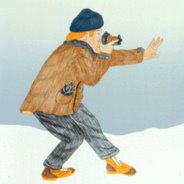Draft: Atagutaaluk survived starvation in 1905 near Pond Inlet. The shaman Palluq and his wife Tagurnaaq and Atuat from Igloolik and Repulse Bay found her near Tariuju, closer to Mittimatalik. (See Rose Iqallijuq 1998)who also described another case of survival cannibalism by Kaagat who was found near Igluligaaijuk.) Later Atagutaaluk married the shaman chief Ittuksarjuat. They lived in a qarmaq, a sod or stone house (D'Anglure 2002:222, Rousseliere 1950).
"Ujarak: My sister Atuat knows this person. She knows the story very well. My sister [Atuat] was the adopted daughter of Palluq and [his wife] Tagurnaaq. Tagurnaaq and her husband could not have a baby of their own, so they adopted Atuat. My sister Atuat, who is also called IttukuSuk, was very young at that time, but she was aware of everything that happened. The family, Palluq, Tagurnaaq and Atuat were on their way to Mittimatalik when they found Ataguttaaluk. The family brought Ataguttaaluk to where there were other people and stayed there for some time. Then they set out to the Kivalliq area and stayed there for quite a while (Iqallijuq, Rose and Johanasi Ujarak 1998)."
The Igloolik shaman Atuat died in Arctic Bay in 1976. She was the daughter of Ava and Urulu. According to d'Anglure (2002) Atuat was the last Inuit to have extensive tatoos (2002:220). Atuat did a drawing in Arctic Bay in 1964 "depicting the last major winter-solstice celebration (Tivaajut) which she attended circa 1910 at Igloolik. At the end of the festivities, shamans paired everyone up into new couples for one night (d'Anglure 2002:219)." See illustration in the 2002 publication which accompanies the film Atanarjuat. According to d'Anglure in the early 1920s there were eighty shamans in the greater Igloolik area which included North Baffin to Repulse Bay region. This included fourteen women. By the 1940s all had converted to Christianity. Thirty were still alive in the 1970s. Today their names are alive through their children (d'Anglure 2002:209). [I taught one of the descendents Tabitha Palluq through CITP. Her reaction to the showing of the film starvation was very moving.]
Knud Rasmussen photographed shamans in 1921-2 expedition including Urulu, Atuat's mother, a woman shaman from the area of Igloolik/Repulse Bayand three shaman brothers from Igloolik/Repulse Bay Ivaluarjuak, Ava and Pilaskapsi. See d'Anglure (2002:211).
I remembered having a similar feeling when watching a video about Apphia's celebrated great aunt, 1 Ataguttaaluk Starvation. The video produced by the Women's Video Workshop in Igloolik is part of a series in which women share stories and demonstrate skills such as stretching skins and lighting the kudlik, the seal oil lamp. It bothered me that the video, when shown in the south, was not contextualized. Viewers only hear the voice of an Igloolik elder speaking in Inuktitut (with English subtitles) telling the story of a woman who ate human flesh to survive starvation. The contrast in audience reaction between Igloolingmiut and those who do not know the full story is remarkable. I am invariably riveted by the personal and emotional comments from Igloolingmiut Inuit viewers, some of whom were related to her. Older Igloolingmiut know the full story which is one of courage and love. Individual families have kept stories of the dreams people had the night Ataguttaaluk was found. The local school was named after her. She remarried and lived a long and productive life. With her second husband Ituksarrjuat (and later her sons) they traveled between Igloolik and the trading post in Pond Inlet trading not only their own furs but those of others, ensuring that people would always have enough to eat. She attempted to bring together the estranged Anglican and Catholic groups that had become part of Igloolik's distinctive landscape. Fierce competition for converts stemming from the earliest arrivals of the Anglican and Catholic missionaries led to a divisiveness that is still present as reflected in Sandra's account. The video is a partial account that is situated within a local knowledge. It recounts only a few months, albiet the most traumatic and formative of Ataguttaaluk's youth. It illustrates the specificity of the geographical and temporal moment. For me its viewing to unprepared audiences that were not Igloolingmiut was inappropriate. I understood that the absence of interpretation and synthesis to prepare a southern audience was intentional; it was out of respect for the voice of the elder. One way of reacting is to assume the responsibility of the reader to inform herself of the larger context. The other is to expect a form of accountability on the part of the facilitator who would know southern audiences and who would therefore be able to share concerns with the Igloolik women who made the video, suggesting they might add something to the video to frame it. While she is not the author, but a co-author, this is perhaps the partial role of the researcher, to be aware of the potential readership and to adapt the text to provide the reader with all the tools necessary for making her own interpretation. Photos shown of starvation while the elder speaks are not of Ataguttaaluk but of a much older woman. This added to the confused image of the event: she was only a young teenager when this event took place. I could only know that through the informed members of the audience. My feelings about this are very strong. They influence and perhaps bias my reading of Apphia's story. It is this kind of anger that motivates my research.
Selected Bibliography
Rose Iqallijuq. 1998.
Rousseliere, Guy Mary. 1950. "Monica Ataguttaaluk, Queen of Iglulik." Eskimo. 16:13.
Subscribe to:
Post Comments (Atom)




2 comments:
Hi -
I was very interested in reading Atagutaaluk's fascinating story.
I am researching the family of Capt. George Cleveland, including his wife Tabitia Taututtiaq (aka Tooteecheak) (c.1885 - 1955) of Repulse Bay who has also been referred to as "Tagurnaaq", as well as his daughter Elizabeth Inukpaujaq/Enukpaoyak of Sallit who was married to Uyaraq/Ujarak/Ujaraq.
Do Tagurnaaq and Ujarak of Atagutaaluk's story relate to the Tagurnaaq and Ujarak whom I am researching?
Thank you for any help, and thank you for sharing your research!
Sincerely,
Chris Baer
cbaer@vineyard.net
Post a Comment